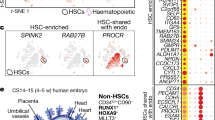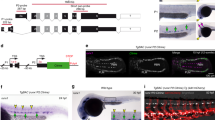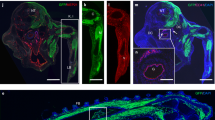Abstract
Haematopoietic stem cells (HSCs), responsible for blood production in the adult mouse, are first detected in the dorsal aorta starting at embryonic day 10.5 (E10.5)1,2,3. Immunohistological analysis of fixed embryo sections has revealed the presence of haematopoietic cell clusters attached to the aortic endothelium where HSCs might localize4,5,6. The origin of HSCs has long been controversial and several candidates of the direct HSC precursors have been proposed (for review see ref. 7), including a specialized endothelial cell population with a haemogenic potential. Such cells have been described both in vitro in the embryonic stem cell (ESC) culture system8,9 and retrospectively in vivo by endothelial lineage tracing5,10 and conditional deletion experiments11. Whether the transition from haemogenic endothelium to HSC actually occurs in the mouse embryonic aorta is still unclear and requires direct and real-time in vivo observation. To address this issue we used time-lapse confocal imaging and a new dissection procedure to visualize the deeply located aorta. Here we show the dynamic de novo emergence of phenotypically defined HSCs (Sca1+, c-kit+, CD41+) directly from ventral aortic haemogenic endothelial cells.
This is a preview of subscription content, access via your institution
Access options
Subscribe to this journal
Receive 51 print issues and online access
$199.00 per year
only $3.90 per issue
Buy this article
- Purchase on Springer Link
- Instant access to full article PDF
Prices may be subject to local taxes which are calculated during checkout



Similar content being viewed by others
References
de Bruijn, M. F., Speck, N. A., Peeters, M. C. & Dzierzak, E. Definitive hematopoietic stem cells first develop within the major arterial regions of the mouse embryo. EMBO J. 19, 2465–2474 (2000)
Medvinsky, A. & Dzierzak, E. Definitive hematopoiesis is autonomously initiated by the AGM region. Cell 86, 897–906 (1996)
Müller, A. M., Medvinsky, A., Strouboulis, J., Grosveld, F. & Dzierzak, E. Development of hematopoietic stem cell activity in the mouse embryo. Immunity 1, 291–301 (1994)
Tavian, M. et al. Aorta-associated CD34+ hematopoietic cells in the early human embryo. Blood 87, 67–72 (1996)
Jaffredo, T., Gautier, R., Eichmann, A. & Dieterlen-Lievre, F. Intraaortic hemopoietic cells are derived from endothelial cells during ontogeny. Development 125, 4575–4583 (1998)
Garcia-Porrero, J. A., Godin, I. E. & Dieterlen-Lievre, F. Potential intraembryonic hemogenic sites at pre-liver stages in the mouse. Anat. Embryol. (Berl.) 192, 425–435 (1995)
Dzierzak, E. & Speck, N. A. Of lineage and legacy: the development of mammalian hematopoietic stem cells. Nature Immunol. 9, 129–136 (2008)
Eilken, H. M., Nishikawa, S. & Schroeder, T. Continuous single-cell imaging of blood generation from haemogenic endothelium. Nature 457, 896–900 (2009)
Lancrin, C. et al. The haemangioblast generates haematopoietic cells through a haemogenic endothelium stage. Nature 457, 892–895 (2009)
Zovein, A. C. et al. Fate tracing reveals the endothelial origin of hematopoietic stem cells. Cell Stem Cell 3, 625–636 (2008)
Chen, M. J., Yokomizo, T., Zeigler, B. M., Dzierzak, E. & Speck, N. A. Runx1 is required for the endothelial to haematopoietic cell transition but not thereafter. Nature 457, 887–891 (2009)
Bertrand, J. Y., Kim, A. D., Teng, S. & Traver, D. CD41+ cmyb+ precursors colonize the zebrafish pronephros by a novel migration route to initiate adult hematopoiesis. Development 135, 1853–1862 (2008)
Kissa, K. et al. Live imaging of emerging hematopoietic stem cells and early thymus colonization. Blood 111, 1147–1156 (2008)
Ma, X., Robin, C., Ottersbach, K. & Dzierzak, E. The Ly-6A (Sca-1) GFP transgene is expressed in all adult mouse hematopoietic stem cells. Stem Cells 20, 514–521 (2002)
de Bruijn, M. F. et al. Hematopoietic stem cells localize to the endothelial cell layer in the midgestation mouse aorta. Immunity 16, 673–683 (2002)
Taoudi, S. & Medvinsky, A. Functional identification of the hematopoietic stem cell niche in the ventral domain of the embryonic dorsal aorta. Proc. Natl Acad. Sci. USA 104, 9399–9403 (2007)
Sánchez, M. J., Holmes, A., Miles, C. & Dzierzak, E. Characterization of the first definitive hematopoietic stem cells in the AGM and liver of the mouse embryo. Immunity 5, 513–525 (1996)
North, T. E. et al. Runx1 expression marks long-term repopulating hematopoietic stem cells in the midgestation mouse embryo. Immunity 16, 661–672 (2002)
Matsubara, A. et al. Endomucin, a CD34-like sialomucin, marks hematopoietic stem cells throughout development. J. Exp. Med. 202, 1483–1492 (2005)
Mikkola, H. K., Fujiwara, Y., Schlaeger, T. M., Traver, D. & Orkin, S. H. Expression of CD41 marks the initiation of definitive hematopoiesis in the mouse embryo. Blood 101, 508–516 (2003)
Corbel, C. & Salaun, J. αIIb integrin expression during development of the murine hemopoietic system. Dev. Biol. 243, 301–311 (2002)
Zhang, J. et al. CD41-YFP mice allow in vivo labeling of megakaryocytic cells and reveal a subset of platelets hyperreactive to thrombin stimulation. Exp. Hematol. 35, 490–499 (2007)
Kumaravelu, P. et al. Quantitative developmental anatomy of definitive haematopoietic stem cells/long-term repopulating units (HSC/RUs): role of the aorta-gonad-mesonephros (AGM) region and the yolk sac in colonisation of the mouse embryonic liver. Development 129, 4891–4899 (2002)
Robin, C. et al. An unexpected role for IL-3 in the embryonic development of hematopoietic stem cells. Dev. Cell 11, 171–180 (2006)
Adamo, L. et al. Biomechanical forces promote embryonic haematopoiesis. Nature 459, 1131–1135 (2009)
North, T. E. et al. Hematopoietic stem cell development is dependent on blood flow. Cell 137, 736–748 (2009)
Taoudi, S. et al. Extensive hematopoietic stem cell generation in the AGM region via maturation of VE-cadherin+CD45+ pre-definitive HSCs. Cell Stem Cell 3, 99–108 (2008)
Molyneaux, K. A., Stallock, J., Schaible, K. & Wylie, C. Time-lapse analysis of living mouse germ cell migration. Dev. Biol. 240, 488–498 (2001)
Cai, Z. et al. Haploinsufficiency of AML1 affects the temporal and spatial generation of hematopoietic stem cells in the mouse embryo. Immunity 13, 423–431 (2000)
North, T. et al. Cbfa2 is required for the formation of intra-aortic hematopoietic clusters. Development 126, 2563–2575 (1999)
Acknowledgements
We thank F. Grosveld for critical discussions, T. Graf and T. Schroeder for the CD41–YFP mice and the department of Neuroscience (Erasmus MC) for the tissue chopper. This work was supported by NWO (Vidi) grant 917-76-345 (C.R., J.-C.B.), NIH R37 DKO54077 (E.D.) and BSIK SCDD 03038 (E.D.).
Author Contributions C.R. and E.D. conceived ideas. C.R. designed the research. C.R and J.-C.B. performed the experiments, analysed the data, interpreted the experiments and made the figures. C.R. and C.A.S. developed the embryo slicing technique. W.v.C. assisted with the confocal microscopy experiments. C.R., J.-C.B. and N.G. made the 3D movies. C.R. and W.v.C. made the 2D movies. C.R., J.-C.B., N.G. and E.D. wrote the manuscript. All authors discussed the results and commented on the manuscript.
Author information
Authors and Affiliations
Corresponding author
Ethics declarations
Competing interests
The authors declare no competing financial interests.
Supplementary information
Supplementary Figures
This file contains Supplementary Figures 1-3 with Legends. (PDF 904 kb)
Supplementary Movie 1
This movie shows the 3D reconstruction of the aorta from a E10 embryo slice. Ventral and dorsal sides of the aorta are specified. The boxed area shows a CD31+ ventral aortic cluster (red, CD31). (MOV 6034 kb)
Supplementary Movie 2
This movie shows the emergence of a Ly-6A GFP+ cell (white arrow) directly from the CD31+ ventral aortic endothelium (Example 1, 20x lens; green, Ly-6A GFP; red, CD31). (MOV 4001 kb)
Supplementary Movie 3
This movie shows the emergence of a Ly-6A GFP+ cell (white arrow) directly from the CD31+ ventral aortic endothelium (Example 2, 20x lens; green, Ly-6A GFP; red, CD31). (MOV 5345 kb)
Supplementary Movie 4
The first part of this movie shows the 3D reconstruction of the aorta from a E10 Ly-6A GFP embryo slice. Ventral/dorsal and front/back sides of the aorta are specified. The white box represents the area where two Ly-6A GFP+ cells will emerge in position of the white and yellow arrows. The second part shows the white box area from the front side (left) and back side (right) perspective of the aorta (40x lens; green, Ly-6A GFP; red, CD31). (MOV 5000 kb)
Supplementary Movie 5
This movie shows the emergence of a Ly-6A GFP+ cell (shown in Supplementary Movie 4, white arrow) in 2D (one z-stack) after deconvolution (40x lens; green, Ly-6A GFP; red, CD31). (MOV 4263 kb)
Supplementary Movie 6
This movie shows the emergence of a Ly-6A GFP+ cell (white arrow) directly from the CD31+ aortic endothelium (40x lens; green, Ly-6A GFP; red, CD31). Ventral and dorsal sides of the aorta are specified. (MOV 9939 kb)
Supplementary Movie 7
This movie shows the emergence of CD41-YFP+ cells (yellow arrow) directly from the ventral CD41- aortic endothelium (40x lens; yellow, CD41-YFP). The emergence and the concomitant YFP expression of the newly formed cells are shown in transmitted light (on the left) and fluorescence (on the right). (MOV 6450 kb)
Supplementary Movie 8
This movie shows the 3D reconstruction of the ventral and lateral sides of an aorta portion from a whole E10 embryo. Notice the hematopoietic clusters attached to the endothelium (40x lens; green, Ly-6A GFP; red, CD31). (MOV 5553 kb)
Supplementary Movie 9
This movie shows the emergence of a GFP+ cell from the aortic endothelium (20x lens; green, Ly-6A GFP). (MOV 7817 kb)
Rights and permissions
About this article
Cite this article
Boisset, JC., van Cappellen, W., Andrieu-Soler, C. et al. In vivo imaging of haematopoietic cells emerging from the mouse aortic endothelium. Nature 464, 116–120 (2010). https://doi.org/10.1038/nature08764
Received:
Accepted:
Published:
Issue Date:
DOI: https://doi.org/10.1038/nature08764
This article is cited by
-
Cis inhibition of NOTCH1 through JAGGED1 sustains embryonic hematopoietic stem cell fate
Nature Communications (2024)
-
Runx1+ vascular smooth muscle cells are essential for hematopoietic stem and progenitor cell development in vivo
Nature Communications (2024)
-
Glia maturation factor-γ is required for initiation and maintenance of hematopoietic stem and progenitor cells
Stem Cell Research & Therapy (2023)
-
Alcam-a and Pdgfr-α are essential for the development of sclerotome-derived stromal cells that support hematopoiesis
Nature Communications (2023)
-
Meis1 establishes the pre-hemogenic endothelial state prior to Runx1 expression
Nature Communications (2023)
Comments
By submitting a comment you agree to abide by our Terms and Community Guidelines. If you find something abusive or that does not comply with our terms or guidelines please flag it as inappropriate.



